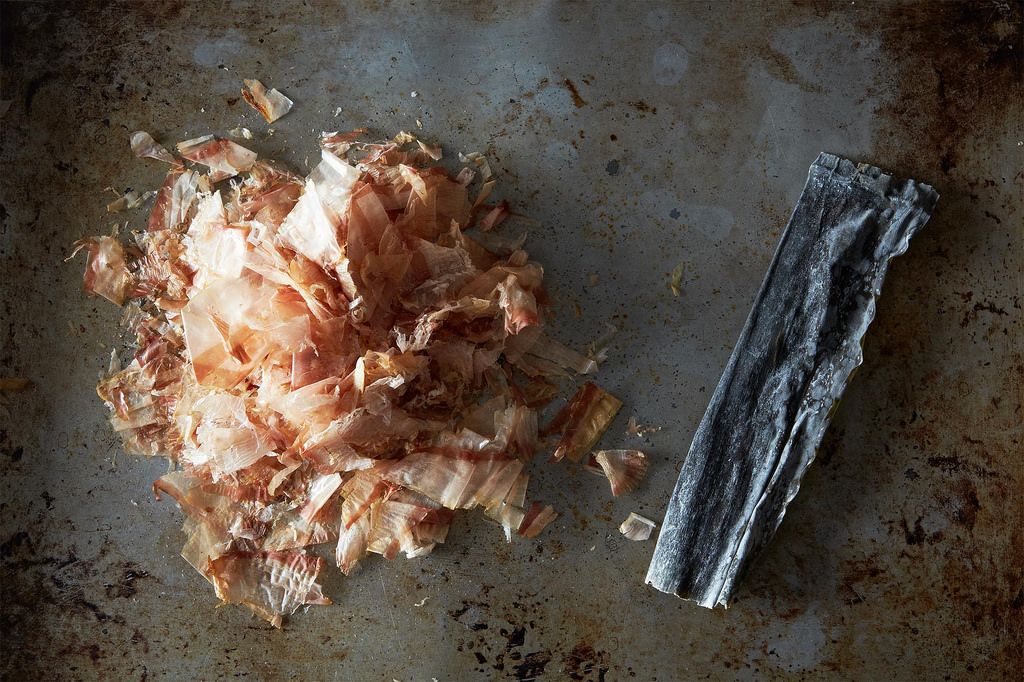 Lightly wipe the Konbu with a well-wrung wet dish towel but do not wipe away the white film on the konbu surface, because that’s were the flavors are hidden. Make several crosswise cuts in the konbu seaweed. This helps to extract the flavor during cooking. Put the konbu and 4 cups of water in a medium. Place the pan over medium heat and cook until the water almost comes to a boil, then pluck out the konbu. Reduce the heat to a simmer. Gently add the bonito flakes and cook for a couple of minutes. Turn off the heat. Strain them through a sieve lined with cheesecloth or paper towels. Don’t stir the stock because that will cloud the dashi. The Dashi should be aromatic and have a honey yellow color. Note: To make the secondary dashi, put 4 ½ cups of water, the used konbu and bonito flakes in a medium pot and bring it to a boil. Turn heat to low and simmer for 5 minutes. Strain the konbu and bonito flakes through a sieve lined with cheesecloth or paper towels. The dashi should have a light honey yellow color.
Lightly wipe the Konbu with a well-wrung wet dish towel but do not wipe away the white film on the konbu surface, because that’s were the flavors are hidden. Make several crosswise cuts in the konbu seaweed. This helps to extract the flavor during cooking. Put the konbu and 4 cups of water in a medium. Place the pan over medium heat and cook until the water almost comes to a boil, then pluck out the konbu. Reduce the heat to a simmer. Gently add the bonito flakes and cook for a couple of minutes. Turn off the heat. Strain them through a sieve lined with cheesecloth or paper towels. Don’t stir the stock because that will cloud the dashi. The Dashi should be aromatic and have a honey yellow color. Note: To make the secondary dashi, put 4 ½ cups of water, the used konbu and bonito flakes in a medium pot and bring it to a boil. Turn heat to low and simmer for 5 minutes. Strain the konbu and bonito flakes through a sieve lined with cheesecloth or paper towels. The dashi should have a light honey yellow color.Dashi is an incredibly simple broth, and it forms one of the culinary cornerstones of Japanese cooking. It's made in about 10 minutes with just three ingredients: water, kombu (dried kelp), and bonito fish flakes. The resulting clear broth tastes like the essence of the sea. Dashi can be used to make a fantastic bowl of miso soup, to poach fish or vegetables, or to add savory umami flavor to any number of Japanese dishes. Here's how you can make it at home. Kombu is a type of kelp that has been dried and cut into sheets. Look closely and you'll see powdery crystals clinging to the surface of the seaweed — these crystals of glutamic acid dissolve in the water and give the dashi much of it's umami flavor. You only need to use a small portion of kombu in each two-cup batch of dashi. You can break off a roughly two-inch piece with your hands or use kitchen shears to cut the kombu into smaller pieces. Be careful not to boil the kombu or else it can give the dashi a bitter flavor and slick texture.
Let the kombu and water warm together in the saucepan, and then remove the kombu just as the water starts to come to a boil. What Are Bonito Flakes, Called katsuobushi in Japanese, bonito flakes come from dried and thinly-shaved bonito fish. They add another layer of ocean-y complexity to this light broth. After simmering the bonito flakes in the broth for a minute or two, let them steep for a few minutes off the heat to deepen the flavors. If you're vegetarian, you can skip the bonito flakes and use the dashi just after removing the kombu from the water. Where to Find Dashi Ingredients, An Asian grocery store is your best bet for finding both kombu and bonito flakes. Whole Foods stores also reliably carry these ingredients. I've also seen more chain grocery stores starting to carry Asian ingredients, so it's worth checking the "international" section at your local store before going on a quest for kombu and bonito flakes. If you're still not having any luck, both ingredients can be purchased online.

0 Komentar